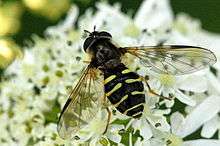Dasysyrphus venustus
Dasysyrphus venustus is a Holarctic species of hoverfly.[1]
| Dasysyrphus venustus | |
|---|---|
 | |
| Dasysyrphus venustus female | |
| Scientific classification | |
| Kingdom: | |
| Phylum: | |
| Class: | |
| Order: | |
| Family: | |
| Genus: | |
| Species: | D. venustus |
| Binomial name | |
| Dasysyrphus venustus (Meigen, 1822) | |
| Synonyms | |
Description
External images
For terms see Morphology of Diptera
Wing length 6·25–10 mm. Eyes hairy. Tergites 3 and 4 with equal-sized yellow patterns. Tergite 2 pale pattern always present, as broad as or broader than pattern on tergites 3 and 4.Face with black longitudinal stripe. Female sternite 2 black at hind margin and dust spots on frons faint.
[2]
[3]
[4][5] Male genitalia are figured by Hippa (1968).[6]
The larva is figured by (Dusek and Laska (1962) [7]
Distribution
Palaearctic. Fennoscandia South to Northern Spain. Ireland eastwards through North and Central Europe. Mountains of Italy, Yugoslavia). East into European and Russian Far East and Siberia to the Pacific coast (Kuril Islands)[8][9]
Biology
Habitat: Fagus, Quercus and Betula woodland, alluvial deciduous forest, Pinus, Picea and Abies forest.[10] Clearings, tracksides and arboreal, descending to visit flowers of white Umbelliferae Acer platanoides, Acer pseudoplatanus, Allium ursinum, Berberis, Caltha, Crataegus, Endymion, Euphorbia, Frangula alnus, Ilex, Lonicera xylosteum, Potentilla erecta, Prunus cerasus, Prunus spinosa, Ranunculus, Rubus idaeus, Salix, Sambucus, Sorbus aucuparia, Stellaria, Taraxacum.[11] The flight period is April to June (later at higher altitudes and more northerly latitudes).
Taxonomy
D. venustus is known to be the most frequent and widely distributed species of the genus. Studies have indicated a very high morphological and genetic variability of D. venustus, suggesting that it is a complex of species. [12] [13]
References
- Stubbs, Alan E.; Falk, Steven J. (1983). British Hoverflies: An Illustrated Identification Guide. British Entomological & Natural History Society. pp. 253, xvpp.
- Van Veen, M. (2004) Hoverflies of Northwest Europe: identification keys to the Syrphidae. 256pp. KNNV Publishing, Utrecht.addendum
- Van der Goot,V.S. (1981) De zweefvliegen van Noordwest - Europa en Europees Rusland, in het bijzonder van de Benelux. KNNV, Uitgave no.32: 275pp. Amsterdam.
- Bei-Bienko, G.Y. & Steyskal, G.C. (1988) Keys to the Insects of the European Part of the USSR, Volume V: Diptera and Siphonaptera, Part I. Amerind Publishing Co., New Delhi. ISBN 81-205-0080-6.
- Coe, R.L. (1953) Diptera: Syrphidae. Handbks.ident.Br.insects, 10(1): 1-98. R.ent.Soc.London. pdf
- Hippa, H. (1968) A generic revision of the genus Syrphus and allied genera (Diptera: Syrphidae) in the Palearctic region, with descriptions of the male genitalia. Acta Ent.Fenn., 25: 1-94.
- Dusek, J. & Laska, P. (1962) Beitrag zur Kenntnis einiger Syrphiden-larven (Diptera, Syrphidae). Acta Soc. Ent. Cechosloveniae, 59: 348-356.
- Fauna Europaea
- Peck, L.V. (1988) Syrphidae. In: Soos, A. & Papp, L. (eds.) Catalogue of Palaearctic Diptera, 8: 11-230. Akad.Kiado, Budapest.
- Speight, M.C.D. (2011). "Species accounts of European Syrphidae (Diptera)" (PDF). Syrph the Net, the database of European Syrphidae. 65: 285pp.
- de Buck, N. (1990) Bloembezoek en bestuivingsecologie van Zweefvliegen (Diptera, Syrphidae) in het bijzonder voor België. Doc.Trav. IRSNB, no.60, 1-167.
- Barkalov A.V. 2007. Hoverflies of the genus Dasysyrphus ENDERLEIN, 1937 (Diptera, Syrphidae) from the Urals, Siberia and the Far East. Eurasian Entomological Journal 6: 273-298.
- Locke M.M., Skevington J.H. 2013. Revision of Nearctic Dasysyrphus ENDERLEIN (Diptera: Syrphidae). Zootaxa 3660: 1-80.